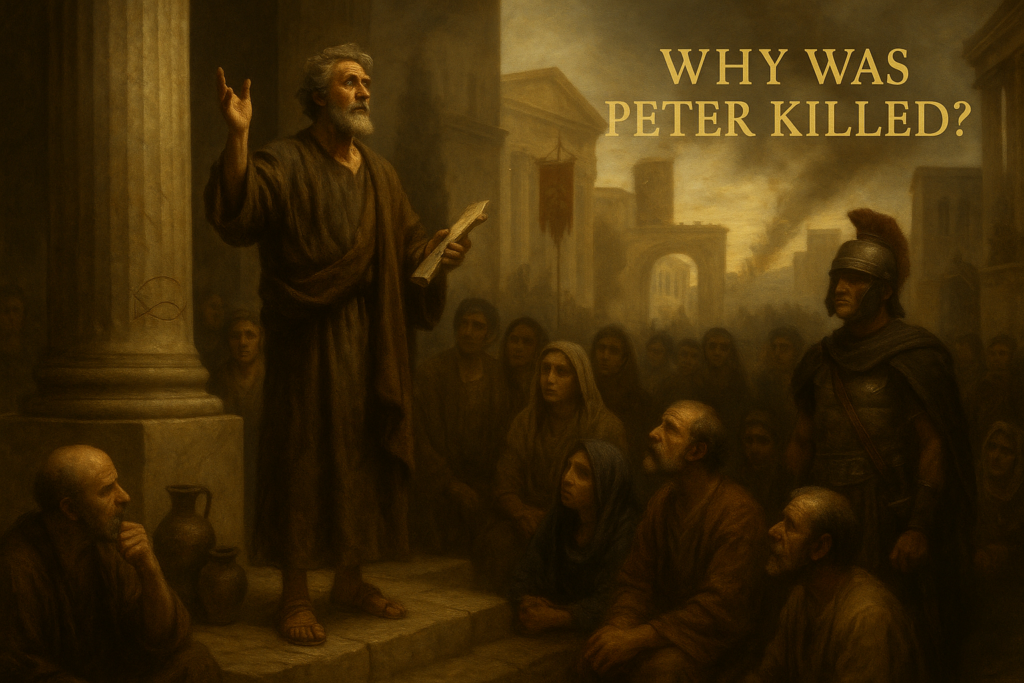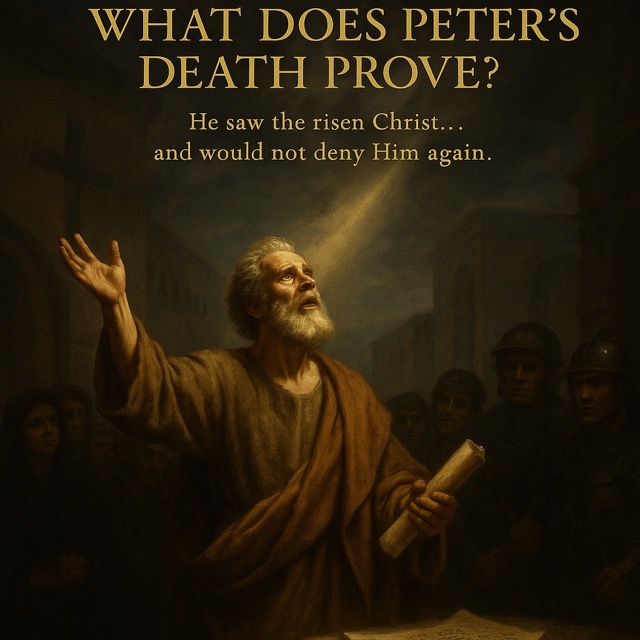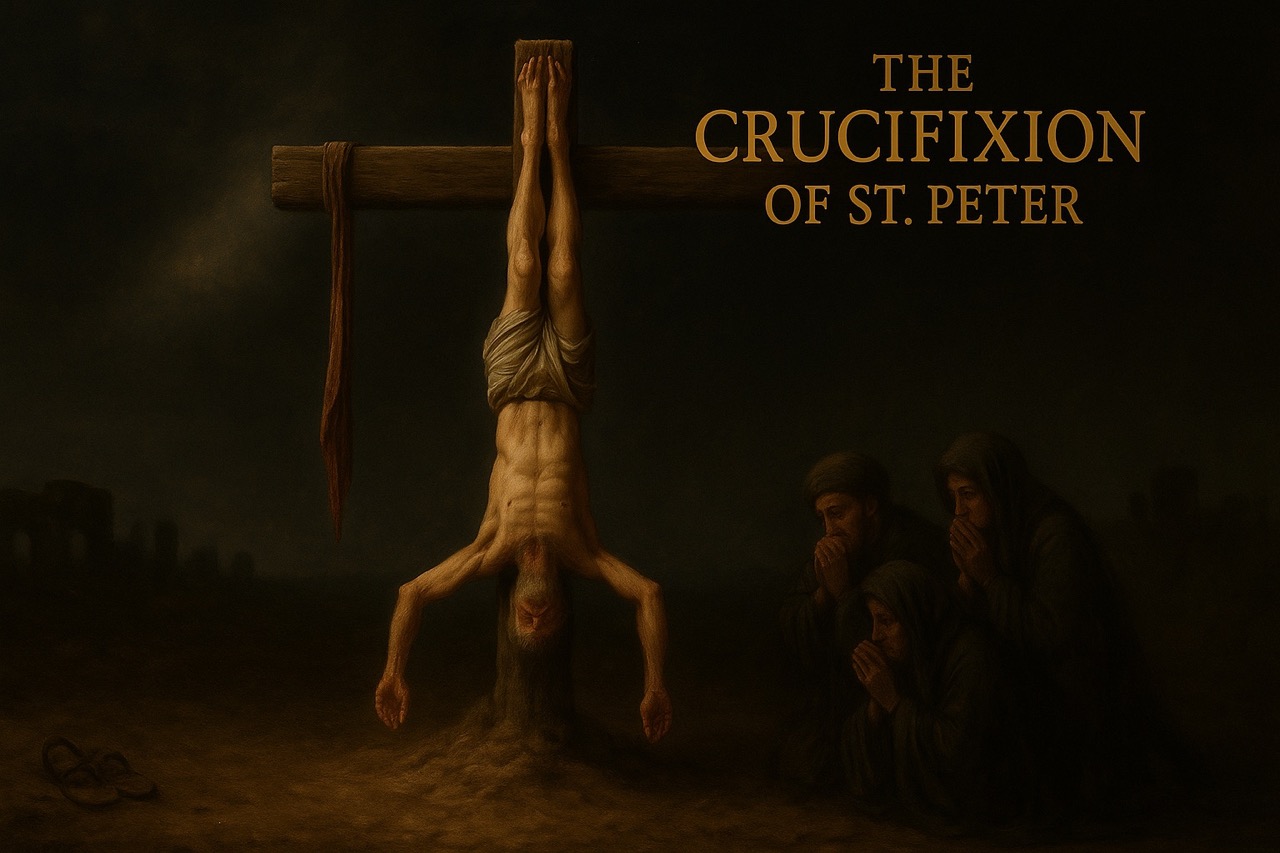“Peter’s martyrdom is one of the strongest historical and spiritual proofs that Jesus rose from the dead.”
Peter wasn’t just a disciple — he was the first to follow, the loudest to speak, and the boldest to fall. He walked on water, saw the glory of the transfiguration, and vowed he would die for Jesus — only to deny Him three times in His hour of need.
But after the resurrection, everything changed.
Peter became the fearless leader of the early church… and when death came knocking again, he didn’t run.
This time, he faced the cross willingly — but asked to be crucified upside down, saying he was not worthy to die in the same manner as his Lord.
💀 They didn’t die for a lie.
See how all of Jesus’s disciples died — and what it proves.

👣 Who Was Peter to Jesus?
Peter (originally named Simon) was a fisherman on the Sea of Galilee — ordinary, impulsive, and uneducated. But Jesus saw something eternal in him. He gave him the name Cephas (Petros in Greek, meaning “Rock”) and called him to follow:
“Come, follow Me, and I will make you a fisher of men.” (Matthew 4:19)
Peter was part of Jesus’s inner circle, along with James and John. He:
- Walked on water when Jesus called (Matthew 14:28–31)
- Witnessed the Transfiguration (Matthew 17:1–9)
- Was present in the Garden of Gethsemane (Mark 14:33–42)
- Was the first to confess: “You are the Christ, the Son of the Living God” (Matthew 16:16)
Yet, he was also deeply human:
- He argued with Jesus
- He tried to stop Jesus from going to the cross
- He famously denied Jesus three times during His trial (Luke 22:54–62)
But Jesus didn’t leave Peter in shame.
After His resurrection, Jesus restored him by the fire (John 21:15–17), asking three times, “Do you love Me?” Then He gave him a new calling:
“Feed My sheep… when you are old, you will stretch out your hands, and someone else will dress you and lead you where you do not want to go.” (John 21:18)
It was a prophecy of how Peter would die.

📖 Biblical Foundations of Peter’s Martyrdom
Peter’s presence dominates the Gospels and the Book of Acts — not just as a follower, but as a flawed man transformed by grace.
🔹 The Gospels: Boldness, Failure, and Restoration
Peter is mentioned more than any other disciple. He’s portrayed as the one who speaks first, acts impulsively, and stands closest to Jesus:
- Confession of Christ:
“You are the Christ, the Son of the living God.” (Matthew 16:16)
Jesus responds: “On this rock I will build My church.” (v.18) - Denial of Jesus:
Despite vowing loyalty (Mark 14:29–31), Peter denies Him three times. The rooster crows, and Peter weeps bitterly (Luke 22:60–62). - Restoration by Jesus:
In John 21, Jesus gently reinstates Peter with three questions — “Do you love Me?” — symbolically undoing the three denials.
This moment defines Peter’s second calling: to lead, to feed, to die well.
🔹 Acts: A Bold Witness to the Risen Christ
In Acts, Peter becomes a lion.
- Pentecost Preaching:
Peter preaches to thousands, proclaiming Jesus’s resurrection and leading over 3,000 to salvation in a single day (Acts 2). - Miracles and Arrests:
He heals the lame, confronts the Sanhedrin, and performs bold miracles — even raising the dead (Acts 9:36–43). - Fearless Before Death:
When told to stop preaching Jesus, Peter responds: “We must obey God rather than men.” (Acts 5:29)
He is beaten, imprisoned, and threatened — but never backs down.
🔹 Peter’s Letters: Strength Through Suffering
Peter authored 1 Peter and 2 Peter, both focused on suffering, persecution, and future glory.
- “Rejoice that you participate in the sufferings of Christ…” (1 Peter 4:13)
- “I know that the putting off of my body will be soon…” (2 Peter 1:14)
He knew what awaited him.
And he embraced it.

⚔️ Why Peter’s Martyrdom Shook the Roman Empire
Peter wasn’t executed for a crime — he was killed because he wouldn’t stop preaching the resurrection of Jesus.
🔹 A Threat to Rome
By proclaiming that Jesus is Lord, Peter was directly challenging the Roman Empire’s central claim: Caesar is lord.
In the Roman world, loyalty to Caesar was more than political — it was religious. Christians like Peter refused to bow to the emperor or offer sacrifices to pagan gods. They claimed allegiance to a crucified Jew, risen from the dead — and preached that His kingdom was coming.
That message was incendiary.
Peter wasn’t killed for being religious.
He was killed for claiming that Jesus, not Caesar, was King.
🔹 Preaching Where He Wasn’t Welcome
Church tradition holds that Peter eventually traveled to Rome, the heart of the empire, and led the early Christian church there. He preached boldly, baptized converts, and defied Roman expectations of submission.
According to early sources like Clement of Rome and Eusebius, Peter’s growing influence made him a target under Emperor Nero, especially after Nero blamed Christians for the Great Fire of Rome (64 A.D.).
Peter’s leadership made him a visible symbol of the faith — and a threat to the state.
🔹 He Could Have Fled — But Chose to Stay
One early Christian account (from the apocryphal Acts of Peter) says that Peter was leaving Rome to avoid arrest — when he had a vision of Jesus walking the other direction.
“Lord, where are You going?” Peter asked.
Jesus replied: “I am going to Rome to be crucified again.”
Convicted, Peter turned around… and walked back into the city.
Back into danger.
Back into death.

🩸 The Crucifixion of Peter: How His Martyrdom Fulfilled Prophecy
Peter’s death is not recorded in the Bible — but early Christian writers, Roman historians, and Church Fathers give us a vivid and consistent picture of how it happened.
🔹 Crucified in Rome Under Nero
According to multiple early sources, Peter was arrested and executed in Rome during the brutal persecution of Christians under Emperor Nero, around 64–67 A.D.
Clement of Rome, writing around 95 A.D., said:
“Peter… having borne his testimony, went to the place of glory that was due to him.”
Eusebius (4th-century church historian) adds that Peter was:
“Crucified at Rome with his head downwards, as he himself had desired to suffer.”
🔹 Why Upside Down?
Peter is said to have requested to be crucified upside down, feeling unworthy to die in the same way as Jesus. This detail comes from the Acts of Peter (a 2nd-century Christian text), which, while not Scripture, reflects early Christian tradition.
Imagine the agony: nailed to a cross, hanging inverted — every breath harder than the last.
Yet Peter chose it… because he remembered the face of the risen Christ.
🔹 Burial and Legacy
Early Christians venerated the spot where Peter was buried — and centuries later, St. Peter’s Basilica was built over what many believe is his tomb. In 1950, bones were discovered beneath the altar bearing signs of first-century Roman crucifixion.
Peter died as he lived after the resurrection: bold, surrendered, and unshakably convinced that Jesus was Lord — even unto death.

🚪 Could He Have Escaped?
Yes.
Peter absolutely could have avoided martyrdom — and that’s what makes his death so powerful.
🔹 He Had Every Exit Available
- He had the status of a respected apostle.
- He had followers who could have protected him.
- He could have gone silent, returned to fishing, or even fled Rome permanently.
Peter wasn’t arrested as a criminal. He was killed because he kept preaching — loudly, publicly, and fearlessly — in the most dangerous city in the world.
🔹 He Could Have Recanted
Under Roman law, it was simple:
Renounce Jesus. Acknowledge Caesar. Live.
All Peter had to do was deny that Jesus rose from the dead.
But the same man who once denied Jesus out of fear…
…would not do it again.
He had seen the empty tomb.
He had touched the risen Christ.
He had eaten with Him by the fire.Peter knew the truth — and he would rather die than deny it again.
🔹 What Makes Martyrdom Meaningful
Many people die for what they believe is true.
But Peter died for what he knew was either true or false.
And that’s the difference.
He was there.
He saw.
And when given the chance to save his life… he chose the cross.

👁️ What Does Peter’s Death Prove?
Peter’s upside-down crucifixion wasn’t a political statement.
It was a final sermon.
🔹 He Didn’t Die for a Philosophy — He Died for a Person
Peter didn’t go to his death defending an abstract religion or moral code.
He died because he believed — with his whole body — that Jesus Christ was alive.
And he would not deny what he saw with his own eyes.
“We did not follow cleverly devised myths… but we were eyewitnesses of His majesty.”
— 2 Peter 1:16
This wasn’t secondhand faith. It was firsthand testimony, sealed in blood.
🔹 He Fulfilled Jesus’s Prophecy
In John 21, Jesus told Peter exactly how he would die:
“When you are old, you will stretch out your hands, and someone else will dress you and lead you where you do not want to go.”
— John 21:18
John adds:
“Jesus said this to indicate the kind of death by which Peter would glorify God.” (v.19)
Peter didn’t just believe in Jesus.
He fulfilled His words — even in the way he died.
🔹 Peter’s Martyrdom as Evidence for the Resurrection
Ask yourself:
Would Peter have endured Roman torture for something he made up?
Would he have asked to be crucified upside down…
…for a story he invented?
Not a chance.
Peter’s death screams what his mouth once confessed:
“You are the Christ — the Son of the Living God.” (Matthew 16:16)

📖 Spiritual Reflection: What Peter Teaches Us Today
Peter was once impulsive, fearful, and inconsistent.
But he became the rock upon which the early church stood — because he let grace remake him.
His life is proof that Jesus doesn’t call the qualified…
He qualifies the called.
🔹 Failure Didn’t Disqualify Him — It Prepared Him
Peter’s denial wasn’t the end of his story — it was the moment he realized his weakness.
And in that brokenness, Jesus met him with restoration.
“Do you love Me?”
“Yes, Lord.”
“Then feed My sheep.” (John 21)
Jesus didn’t shame Peter.
He sent him.
The same man who fell in fear became a fearless witness — because resurrection changes everything.
🔹 What About Us?
We may not face Roman crosses…
But we do face cultural pressure, ridicule, compromise, and spiritual weariness.
Peter shows us what it means to:
- Stand when it’s easier to sit
- Speak truth when silence is safer
- Love Jesus more than we love our lives
His death isn’t just a chapter in history.
It’s a challenge to us:
Will we live like the resurrection is real?
📚 Related Reading on Paranoid Prophet
- Historical Evidence of Jesus
Explore ancient writings and archaeology that confirm the historical reality of Jesus of Nazareth. - Was Jesus a Liar?
Examine the evidence for Jesus’s truthfulness through prophecy, behavior, and resurrection. - Was Jesus a Madman?
Analyze whether Jesus’s teachings, actions, and legacy show signs of delusion or divine mission. - Prophecies of Jesus Fulfilled in Scripture
See 351 Old Testament prophecies fulfilled in the life, death, and resurrection of Christ. - The Martyrdom of Jesus’s Disciples
Discover how the apostles died for their faith — and what it proves about the resurrection. - Messianic Prophecies: Jesus’s Crucifixion
See the detailed prophecies in Isaiah 53 and Psalm 22 fulfilled at the cross. - Prophecies of Jesus’s Resurrection
Explore Old Testament predictions about Christ’s rising and their New Testament fulfillment. - Prophecies of Jesus’s Ministry
How Jesus’s miracles, teachings, and mission fulfilled Messianic prophecy. - Prophecies of Jesus’s Birth
From Bethlehem to the virgin birth — fulfillments from Isaiah, Micah, and more. - Prophecies of Jesus’s Divine Identity
What scripture says about the Messiah as God’s Son, Judge, and King. - Messianic Prophecies of Jesus the Redeemer
Explore the typological and direct prophecies of Jesus’s role as Savior. - Eschatological Prophecies of Jesus
What the Bible says about Jesus’s return, reign, and the new creation. - Who Is God?
An exploration of God’s biblical attributes — justice, mercy, power, and presence.
Trusted Sources
1. Britannica: The Position of Peter in the Apostolic Church
- This article outlines Peter’s leadership among the Twelve Apostles, detailing his missionary journeys, including his outreach to the Samaritans, and his role in the early Christian community. Encyclopedia Britannica
2. Bart Ehrman: Quest for the Historical Apostle Peter
- Renowned scholar Bart Ehrman examines the historical evidence for Peter’s life, discussing his background as a fisherman and his prominence in early Christian writings. Bart Ehrman Courses Online
3. Biblical Archaeology Society: The Apostle Peter in Rome
- This article explores the archaeological findings related to Peter’s presence in Rome, including discussions about the tropaion and early Christian traditions concerning his martyrdom. Biblical Archaeology Society+1Encyclopedia Britannica+1
4. EWTN: The Date of Peter’s Martyrdom
- EWTN provides an analysis of historical sources to determine the likely date of Peter’s martyrdom, discussing the context of Nero’s persecution of Christians in Rome. EWTN Global Catholic Television Network
5. BibleScripture.net: 5 Ways St. Peter Contributed to Early Christianity
- This resource highlights Peter’s significant contributions to the spread of Christianity, including his public confession of Jesus as the Messiah and his mission to the Gentiles. Bible Scripture

🙋♂️ Frequently Asked Questions: The Martyrdom of the Apostle Peter
How did the Apostle Peter die, according to historical accounts?
Peter is believed to have died by crucifixion in Rome around 64 AD during the reign of Emperor Nero. Early Christian writers like Clement of Rome and Origen confirm this tradition. His death is seen as a fulfillment of Jesus’s prophecy in John 21:18–19, where Jesus foretold Peter’s eventual martyrdom.
Why was Peter crucified upside down?
According to ancient tradition, Peter requested to be crucified upside down because he felt unworthy to die in the same manner as Jesus. This act of humility became one of the most powerful symbols of his faith and devotion. The upside-down cross is now known as the Cross of Saint Peter.
Is there archaeological or historical evidence of Peter’s martyrdom?
While the New Testament does not directly record Peter’s death, early Church Fathers—including Origen, Tertullian, and Jerome—affirm his crucifixion in Rome. Additionally, a monument believed to mark his tomb was discovered beneath St. Peter’s Basilica in the Vatican, lending archaeological support to the tradition.
What was Peter’s relationship with Jesus like during His ministry?
Peter was one of Jesus’s closest disciples and part of His inner circle, along with James and John. He was the first to declare Jesus as the Messiah (Matthew 16:16) and witnessed the Transfiguration. Despite denying Jesus three times before the crucifixion, Peter was restored and became a central leader in the early Church.
Could Peter have avoided martyrdom?
Yes—historically, Peter could have denied Christ or gone into hiding to avoid execution. But instead, he boldly continued preaching the Gospel in Rome, knowing it would likely cost him his life. His refusal to recant affirms the sincerity of his faith and eyewitness testimony of Jesus’s resurrection.
Why does Peter’s martyrdom matter to Christians today?
Peter’s willingness to die for his faith is seen as powerful evidence that the apostles truly believed in the resurrection of Jesus. No one knowingly dies for a lie. His martyrdom also serves as a model of courage, humility, and conviction for believers facing trials or persecution today.
Where did Peter die, and what is the significance of that location?
Peter is believed to have been executed in Rome, near the Circus of Nero. According to Church tradition, he was buried nearby, and his tomb became the foundation of St. Peter’s Basilica. This site has become one of the most significant pilgrimage destinations in all of Christianity.
Was Peter the only apostle martyred for following Jesus?
No—almost all of Jesus’s original disciples were martyred for their faith. Peter’s death is among the most documented, but others like Paul (beheaded), Andrew (crucified on an X-shaped cross), and Thomas (speared in India) also gave their lives spreading the Gospel. Their sacrifices collectively affirm the truth of the resurrection message.




